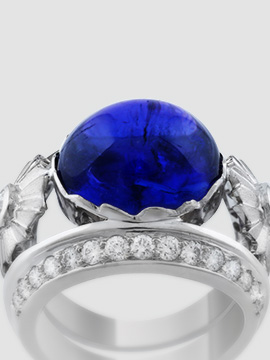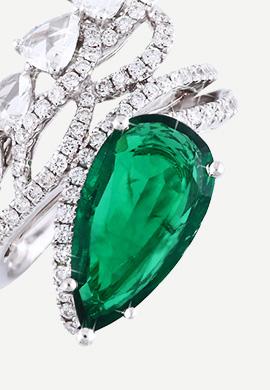Choosing The Right Gemstone
Gemstones are valuable, lustrous rare mineral crystals that come in almost every shade of every colour. In their most natural state, they can appear rough, unrefined and not-so-spectacular. However, when cut, faceted and polished, these same gemstones make wonderful, expensive jewels.
Quality gemstones are durable. They are strong enough to withstand scratches or any damage and do not change when exposed to heat, light or chemical processes. Out of every 2,700 minerals that are found in nature, less than 100 are gemstones. Most of them are silicates, oxides, or quartzes.
Qualities of a gemstone
Colour
The most important quality is colour. Colour makes up about 50 to 70 percent of the value of a gemstone. Hue, tone as well as saturation are other factors.
Hue
Hue refers to the base colour of the gemstone. This is the colour you perceive when you first look at the gemstone. According to the Gemological Institute of America, there exist 31 base hues: 7 of the most basic colours and 24 other combinations.
Tone
Tone refers to the lightness or darkness of the colour. It can be dark, medium, or light. GIA differentiates 11 tones, from white or colourless, to black. Black and white are not considered hues but extreme tones.
Saturation
Saturation shows how intense a color is. According to the GIA, there are cool hues (e.g. green, blue, purple) and warm hues (e.g. orange, red, yellow). Cool hues may have a grey shade when their colours are not saturated. Warm hues with a less intense colour may look brownish. GIA distinguishes 6 degrees of saturation, from grey/brown to vivid. The most valued gemstones have saturation levels of moderately strong, strong or vivid.
The more saturated the precious stone, the darker its tone. The most valuable ones are rated medium or medium dark, with values on the tone scale between 5 to 6. The desirability of the tone also depends on the type of gemstone, for example, aquamarine has a lighter blue than sapphire, keeping in mind the lighting when you observe a gem on display. Will it look the same under different lighting conditions?
Clarity
Clarity is also an important factor; you should be able to tell whether a gemstone has smaller imperfections on the inside or on its surface. Internal imperfections are called inclusions, while imperfections on the surface are called blemishes. GIA has 3 different types to differentiate clarity.
Inclusions are not always wrong, for example, cat’s eye or star sapphire must have inclusions to look the way they should.
Why Buy Gemstones?
Gemstones make great fashion accessories – an obvious reason why many people buy them. A lesser known reason is that they also make solid investments. Since gemstones appreciate in value, they can be sold over time for a profit.
READY TO BUY GEMSTONES?
Looking to glam up with a little fashionable-something for a glitzy event? Perhaps an expensive gift for a special someone? Either way, understanding a thing or two about gemstones might come in handy. For a start, note that not all dealers can be completely trusted, so make sure you are making your purchase from one with valid accreditation.
We at Exotic Gems and Jewellery give you the assurance of expert advice and reliable quality. With over 25 years of experience in the industry, we have garnered a following of loyal and satisfied customers who can attest to our service and workmanship.
Let us work on your request:
• You select a stone,
• We get the perfect one for you,
• and set them into a fine jewellery.
Along with the four most valuable gemstones, we also deal with semi-precious stones such as Tanzanite, Tourmaline, Kunzite, Morganite, Fire Opals, Tahitian South Sea pearls, Garnet, and many others.
Here you can find a list of the most desirable gemstones we often deal with.

Sapphire
Sapphires are blue precious stones (some may come in other colours such as pink, orange or purple). The most valuable ones are in rich, purple-blue colour. The bluer sapphires are, the higher their prices are as well. The most expensive luxurious sapphires are from Burma, Kashmir and Sri Lanka.

Ruby
Rubies come in a bold, bright crimson colour. They may appear in shades that blend with the original color; rubies can be bluish-red, flaming orange red, or a purple hue. Blood red or pigeon blood rubies are the most valuable.

Emerald
Emeralds are vibrant green gemstones. The richer and brighter the shade of green is, the more the emerald is worth. Emeralds that have a rich blue-green shade have the highest value. Emeralds typically have inclusions that are visible to the naked eye. Inclusions in Emeralds are generally acceptable. Eye-clean Emeralds are extremely valuable as they are very rare.

Diamond
Diamonds are probably the most glorious gemstones. On the Mohs Scale, the diamond is rated a level of ten, making it the hardest natural material around. GIA measures diamonds on four qualities: colour, clarity, cut, and carat weight. Colourless diamonds are the most expensive. They come in grades of D, E of F, and since their differences are scarcely noticeable, only diamond experts are able to decide which category a diamond belongs to.